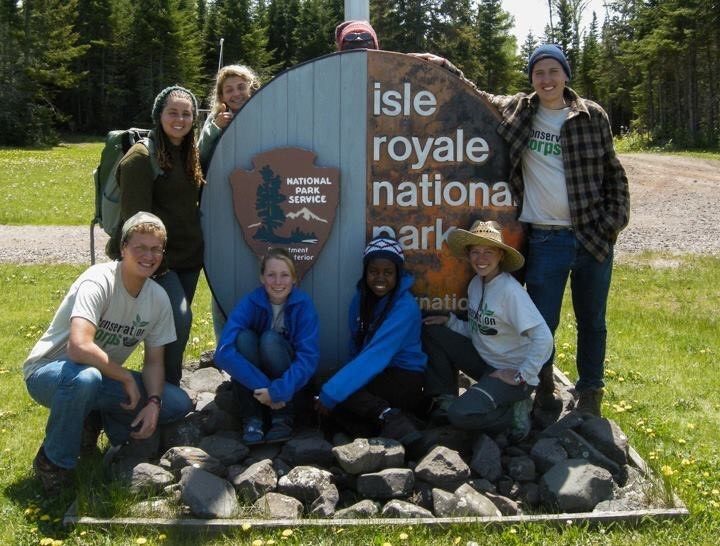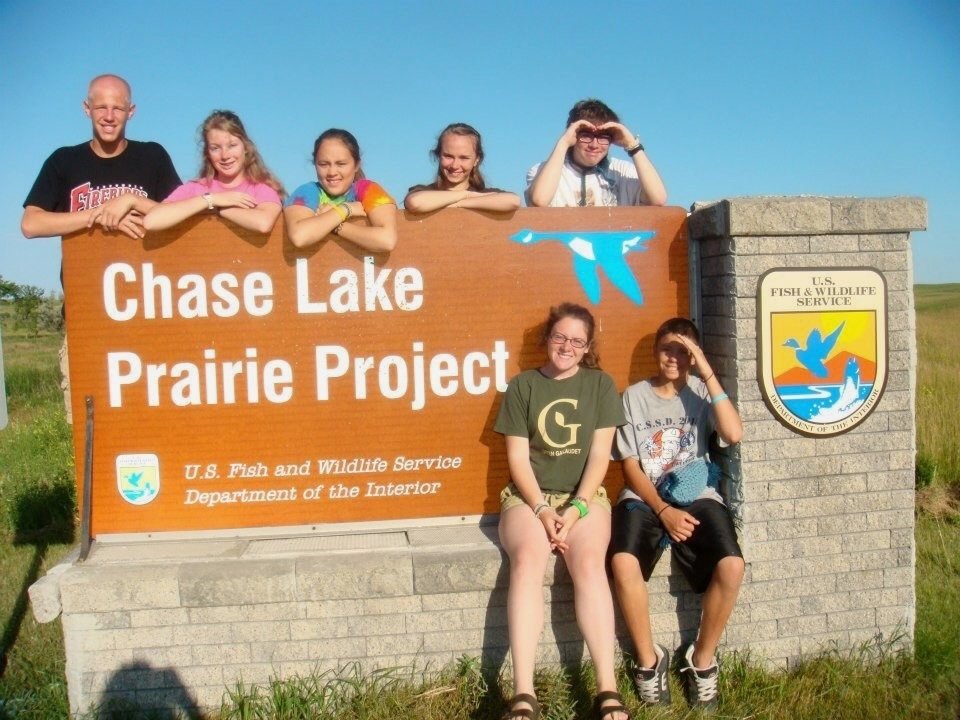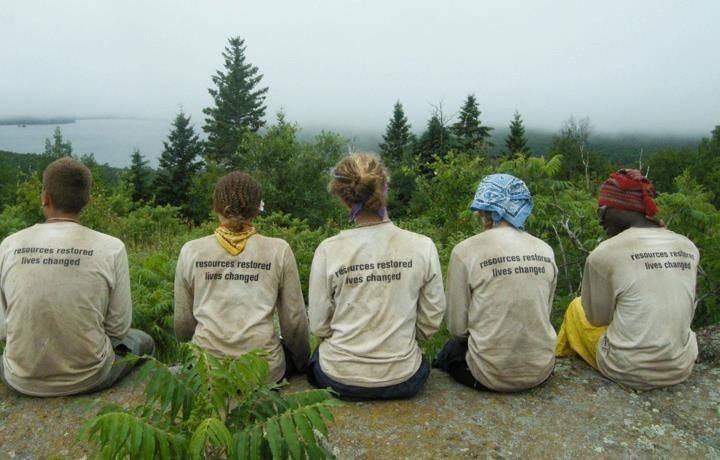Corpsmember Spotlight: Margaret Krueger

By Gina Hatch, AmeriCorps member
Margaret Krueger’s time with the Conservation Corps has taken her on adventures to places that natural resource professionals might dream of – from remote lakes and islands within Isle Royale National Park, to far reaches of the Lake Superior Hiking Trail, to a National Wildlife Refuge home to the largest breeding colony of American White pelicans on the continent.
And that was all while she was still in high school.
Today, having earned a degree in Environmental Studies from Hamline University, Margaret has returned to the Corps under the Individual Placement program and landed in another haven of outdoor enthusiasts – although one with markedly different scenery: the offices of the Minnesota Department of Natural Resources in Saint Paul. Switching from the field to the office for this position is an adjustment, she admits. But she’s excited and ready for the growth it will bring. “It’s great practice to hone new skills and gain professional development, as opposed to focusing mainly on technical skills. It’s been challenging so far but I’m looking forward to it.”
Margaret’s story, from age 16 to 24, exemplifies the arc of personal and professional development that serving with the Conservation Corps can provide. And throughout this story, she has modeled the open-mindedness, flexibility and adventurousness needed to seize these opportunities for expansion and fully reap the rewards.
So how did it all start?
Margaret first joined the Corps at age 16, after watching her older sister participate in Summer Youth Corps (SYC), a program that takes youth ages 15 to 18 camping around the Midwest to complete hands-on conservation projects. “As a little sister I watched her go through the program and really got interested. She returned to it for three years in a row and I got to see her gain networking skills and make lifelong friends.” Following in her sister’s footsteps, Margaret also completed three terms of SYC taking her through the end of high school.
Each of her terms with SYC was a different experience, but the value and pay-off of adaptability was a common theme throughout. During her first term as a youth crew member in 2012, wind storm damage from the previous year left SYC participants at a back-up base camp and changed the operation of the program so that crews were sent on service trips longer and more far-flung than usual. Margaret’s crew ended up on a two-week trip in the Chase Lake area of North Dakota. The first part of the trip was spent on a prairie restoration project, while the latter part had the crew banding American White pelicans at the Chase Lake National Wildlife Refuge.

Margaret with her Summer Youth Corps crew at the entrance to the Chase Lake Prairie Project in 2012.
“It was a really unique experience! The pelicans mainly nest on this one island so we took a small paddle boat out and banded the birds that were still adolescents and couldn’t fly yet. (The adults just see you and fly away.) You have to move very slowly there because there are several thousand birds nesting and you don’t want anything to get trampled.” Margaret’s crew was indeed in a very special place; the island is designated as one of the top 100 Globally Important Birding Areas in the United States. “It was incredible research that we got to help out with, and that research has helped restore the pelican population on that island. That was definitely a highlight of the program – and a very exceptional opportunity that we had because of the unusual circumstances of SYC that year.”
For her second term with the Summer Youth Corps, Margaret took advantage of her previous experience to join the Wilderness Crew, which is an option specifically for returning youth members. The Wilderness Crew brought her to Isle Royale National Park in Lake Superior to work with the National Park Service on maintenance of the Greenstone Ridge Trail.
“That summer was structured so that we had 10-day increments of work and then four or five days off. The National Park Service schedules their work that way because it can take so long to get to work sites there; sometimes you have to bushwack and portage in.” Still, the atypical schedule came with its perks. During their long periods off the crew got to go on extended hikes around the park and enjoy their time relaxing in the company of National Park Service staff. And of course, all that time spent working and wandering the remote island resulted in some enviable wildlife encounters! “There were several times when were just hiking or working and would see a moose and her babies or something else incredible.” Margaret and her crew even got to meet the researchers studying the island’s wolf and moose populations.

Margaret’s 2013 Wilderness Crew near the Greenstone Ridge Trail on Isle Royale National Park.
Finally, during her third term with SYC, Margaret ventured into a somewhat different role and served as a “swamper.” “A swamper is essentially a gopher, so that position requires an incredibly flexible person. American Sign Language is a significant part of SYC and the sign for swamper is essentially ‘doer person,’ and that’s exactly right.” As a swamper Margaret spent much of her time either filling in for Crew Leaders or back at the base camp running the kitchen and managing other logistics. Acting as a Crew Leader, she got to lead trail maintenance work along the north shore of Lake Superior, at Tettegouche and Gooseberry Falls state parks, as well as on the Superior Hiking Trail, a portion of the term that she remembers very fondly.
Margaret’s service with the Conservation Corps paused here while she went on to Hamline University to pursue a degree in Environmental Studies with a minor in Biology and a focus in Secondary Education. Although, in some sense, her experience with the Corps never really left her, because the work she did as a youth corpsmember strongly guided her academic trajectory. “Coming into college I knew exactly what I wanted to get my degree in and that was because of the Corps. I’d always had an interest in the environment and natural resources, but that got much more specific through the Summer Youth Corps and that experience helped me make a lot of decisions. I definitely would not be where I am had it not been for those service terms in high school.”
Back to the present, Margaret has returned once again to the Conservation Corps seeking the next step to build on her field skills and academic background in environmental education. In January of this year she began a year-long Individual Placement position serving as a Youth Outreach Specialist with the Parks and Trails division of the Minnesota Department of Natural Resources (DNR). And that SYC experience from high school is still proving foundational as she builds her professional network: “One of the main things I learned with the Corps was how to meet and connect to new people, and that’s exactly what I’m doing now. It’s a slightly different context, but that’s a lifelong skill that I’m definitely carrying into this job.”
In addition to those general networking skills, Margaret’s work with SYC is helping her out in more specific and specialized ways as she starts to build curricula for the DNR’s I Can Camp! and I Can Paddle! programs. These summer offerings introduce Minnesota families to various outdoor recreation activities while also educating them about local ecology and natural resources. To get launched on this ambitious project, Margaret will be connecting with Corps staff to access some of the environmental education resources she used as an SYC member and essentially facilitating a collaboration between the Corps and the DNR.
Reflecting back on her experience with the Corps so far, Margaret can easily pick out another key way in which her service experience has stuck with her and exerted far-reaching influence: “SYC taught me how to maintain a positive mental attitude in any situation – not just through physical challenges, but also through changing mental and emotional conditions, and that’s something I still carry with me. It’s a skill that has applied not just to my work experience but to my whole life.”
To new members just embarking on their service term, she advises practicing this positive mental attitude through thick and thin. “If you focus on doing that the experience will be so much better. And it effects what you’re physically capable of doing.” The triumphs you achieve in the face of apparently impossible tasks, she explains, are “humbling and incredibly valuable.”
She also strongly encourages members to return for multiple terms and stay engaged even after their service. “It’s something incredibly important to what we do at the Corps. We rely a lot on involved alumni and we highly value that network. Plus you’ll come out of it with lifelong friendships.”
Her advice to people who might still be contemplating service with the Conservation Corps?
“Do it! Absolutely do it! I’ve loved my time working for the Conservation Corps so far; it’s probably been the best job I’ve had in my entire life and I’m not exaggerating.”